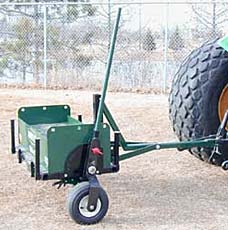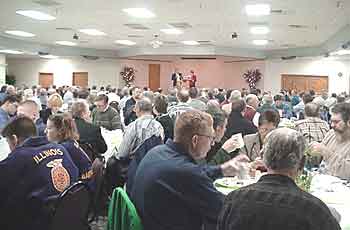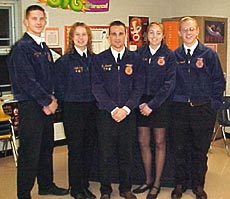|
Features,
Honors
& Awards, Ag
Announcements
Ag News Elsewhere
(fresh daily from the Web)
|
|
Features
|
|
Spring
is here and itís time
to plant; hold that thought
[MARCH
30, 2002] Now
that Illinois has had a few days with freezing rain and snow,
gardeners and farmers alike are eager to begin their spring
planting, but they still need to wait a bit longer and keep frost
dates in mind.
View
spring frost map for Illinois
[The
map is an Adobe Acrobat file. Click
here if you need to download Adobe Acrobat Reader.]
|
|
"The
last spring frost usually occurs between April 7 (southern Illinois) and
April 28 (northern Illinois), and April 14 to 21 (central Illinois), based
on 1971-2000 averages," says Jim Angel, state climatologist with the Illinois
State Water Survey.
"The
actual frost date varies quite a bit from year to year," says Angel. He
suggests adding two weeks to the average frost date for your area before
planting tender plants, to protect them against the possibility of a late
season frost. "By doing so, the odds are only 1 in 10 that frost will
occur later in spring," continues Angel.
Although
32 degrees Fahrenheit is the temperature traditionally used to identify
frost, visible frost can be seen on the ground and on objects at slightly
warmer temperatures on calm, clear nights that allow cold, dense air to
collect near the ground. Under these conditions, the temperature near the
ground actually can be a few degrees cooler than at the 5-foot height of the
official National Weather Service thermometer.

Open,
grassy areas usually experience frost first, while areas under trees are
more protected because the trees help prevent the heat from escaping.
Covering tender plants when a frost is expected can provide this same type
of protection. Plants near heated buildings sometimes are spared too. An
abundance of warm buildings and trees in town means that urban areas tend to
have frost less often than rural areas.
[to top of second column in
this article]
|

According
to Angel, average high temperatures in spring (March-May) range from
the upper 50s (north), to the low 60s (central), to the upper 60s
(south), while the average low temperatures range from the upper 30s
(north), to the lower 40s (central), to the upper 40s (south).
Data
from the Water Survey WARM Network also indicate that soil moisture
across the state is near to above average for this time of year.
"Donít
let the mild winter weíve had fool you into thinking weíll have
a warm spring," cautions Angel. "Historical data indicate
that warm springs do not follow warm winters. Although there is a
tenuous relationship between warm Aprils and earlier dates at which
the last spring frost occurs, it only takes a day or two of
unseasonably cold weather to produce a late spring frost," he
said.
[Illinois
State Water Survey, a division of
the Illinois Department of Natural Resources]

|
|
 |
|
|
Ready,
set, grow!
[MARCH
26, 2002] The
calendar says that spring is here, even though the ice and snow are
with us. One thing about spring, the ice and snow just donít last
very long. This time of year can be a very busy one for getting
things in shape for a great growing season.
|
|
Lawn
care is one thing that should be on everyoneís mind. Itís hard to get
cranked up much about it when there is snow, but timing in the spring is
critical for some operations.

Letís start with crabgrass control.
Crabgrass is an annual grass, which means it comes up from seed every year.
One of the best ways to control annual weeds is to use a seed germination
inhibitor that works on that germinating seed. The only problem is timing.
These herbicides must be put on before you see the weed (in this case, the
crabgrass).
Many
of the germination inhibitors are combined with fertilizer. They should be
applied about April 1 in our area, but the timing can vary a couple of
weeks. The crabgrass seed germinates on the basis of soil temperature, but
one of the good indicators is forsythia in bloom. If you donít have your
crabgrass preventer on by the time you see forsythia blooms, best get it on
quickly. Another thing to keep in mind is that the same product that
prevents crabgrass from germinating will do the same thing to other seeds.
This means that you canít sow new grass seed and use a crabgrass treatment
the same time of year. If you need seeding done, fall is actually the best.
Grass
may be sown either March 15 to April 1 or Aug. 15 to Sept. 10. Spring
seedings donít usually have the success that the fall ones do, because hot
weather tends to hit before lawns become well established. Seeding rates
should be about four pounds of seed per 1,000 square feet for bare dirt, and
half that rate for over-seeding thin areas. We recommend using a blend of
grasses, such as Kentucky bluegrass, a fine fescue and perennial ryegrass.
Some people leave out the perennial ryegrass, but it does provide some
advantages.
[to top of second column in
this article]
|
The
seeding times are also good times to use a plug aerator or use a
power dethatcher. These operations are very hard on grass, and doing
them when the grass recovers quickly goes a long way to keeping your
lawn healthy. Both of these operations are usually done to help
remove thatch layers. This thatch should be no more than one-half
inch in depth, or youíll tend to have disease problems come in.
Fertilizer
and broadleaf weed controls are best applied in May when they work
better. This early in the season, lawn weeds arenít actively
growing, and turf isnít growing actively enough to make good use
of nitrogen fertilizer.
Another
item we have gotten several calls on is dealing with grubs and moles. The two are
often related. Moles eat grubs and earthworms for food. This really
isnít a good time to try to control grubs since they are large in
size and wonít be around too much longer. They will pupate this
spring and come back out as June bugs, Japanese beetles or green
June bugs to start the process all over again. The best control time
is from August through September. Mole control is best accomplished
by doing away with their food source; then they go elsewhere. With
this not being a good time for grub control, you are reduced to
trapping for moles.
Hopefully
these spring lawn tips will get you started on the right track for
the year. If you have further questions, feel free to contact the office at 732-8289.
[John
Fulton, Logan County Unit,
University of Illinois Extension]

|
|
|
Alternative
fuels and proposed ethanol plant are topics at Ag Day breakfast
[MARCH
21, 2002] Fuels
derived from corn and soybeans and a proposed cooperatively owned
ethanol plant in Elkhart were main topics addressed by speakers at
Thursday morningís third annual Logan County Ag Day breakfast. The
breakfast, at the Knights of Columbus building, was sponsored by the
Lincoln/Logan County Chamber of Commerce Agriculture Committee.
View pictures of the
event
|
|
Keynote
speaker Mike Lockart, marketing manager for propane and alternative fuels at
Growmark, said that 11 to 12 percent of the gasoline used in the United
States contains ethanol, and the focus is now shifting to biodiesel fuels.
He defined these as diesel fuels based entirely on soybean, rice, canola or
sunflower seed oils, used cooking fat, or a combination of these. The
American Society for Testing and Materials has set standards for biodiesel
fuels, an important development because it means engine manufacturers
recognize these fuels as a viable alternative to diesel.

[Photo by Bob Frank]
Speaking
to a crowd that filled the Knights of Columbus hall, Lockart said to expect
a new fuel status soon for ethanol-blended diesel fuel, which Growmark is
currently testing.
He
advised those in the agricultural community to watch the numerous state and
federal bills related to setting a standard for renewable fuel. The
terrorist attacks on Sept. 11 have underscored the hidden price for imported
oil, he said, and the result can help corn and soybean producers as well as
improve air quality.
Ernest
Moody, chair of the Land of Lincoln Agriculture Coalition, said the group
will conduct a membership drive in June and plans to offer stock in the
projected Elkhart ethanol plant beginning in January 2003. Only members of
the coalition will be able to buy the stock. Moody said a membership will
cost $500 in the first year and $100 annually after that. He hopes that a
high percentage of stock will be bought locally and that agricultural
producers will purchase at least 51 percent.
[to top of second column in
this article]
|
Based
on a U.S. Department of Agriculture formula and the projected size of the
Elkhart plant, Moody estimated that it will generate 1,000 to 1,500 local
jobs.
Terry
Lock, chair of the ag work force development subcommittee,
introduced winners of three agriculture scholarships:
ē $1,000 to Elizabeth Schilling of Lake Fork, a junior at the University
of Illinois majoring in ag consumer economics.
ē $1,000 to Kent Leesman of Atlanta, a Hartem senior who plans to major
in agronomy at the University of Illinois.
ē $500 to Michael Stoll of Chestnut, a senior at Mount Pulaski who plans
to major in agriculture and animal science at Lincoln Land Community
College. Stoll expects to transfer to University of Illinois to
complete his bachelorís degree.
Emergency
Services and Disaster Agency Coordinator Dan Fulscher noted that
agriculture is the industry with the most work-related accidents
nationwide and advised farmers to make sure their employees carry
cell phones and can identify their location. Over 30 percent of all
local 911 calls are cellular, he said, and many of these callers do
not realize that no technology is in place to give their location.
The
chamber ag committee is chaired by Marty Ahrends; Larry Huelskoetter
headed the Ag Day 2002 committee which planned the breakfast.
Master
of ceremonies Dave Hawkinson, director of marketing and public
affairs for Corn Belt Energy, said, "We appreciate all of you
who participate in the agriculture industry" and thanked those
present for the wisdom and commitment they bring to the community.
[Lynn
Shearer Spellman]
|
|
|
Logan
County fourth-grade students
will learn ĎAgriculture is Everywhereí
[MARCH
20, 2002] Due
to the weather forecast for March 21, the Logan County Farm Bureau
is postponing its second annual Agriculture is Everywhere Fair.
The event has been rescheduled for Thursday, April 11, at the
Logan County Fairgrounds.
|
|
On
the new date, fourth-grade students from Logan County will attend a half-day
fair to discover how agriculture is a world of opportunities and how
people need agriculture in their daily lives. There will be two
sessions, one from 9 to 11:30 a.m. and another from noon to 2:30
p.m. Participation in the event will be near 100 percent of the
county fourth-graders.
The
students will attend five breakout sessions with hands-on activities. The
sessions include dairy, pork, corn, soybeans, machinery and an agricultural
food sampling. The closing segment will focus on sheep and a shearing
demonstration.
|
At
each station, equipment and live animals will be present to expose the
students to agriculture in Logan County.
Members
of the Hartsburg-Emden, Lincoln and Mount Pulaski FFA chapters will be
present to help educate the area students.
The
schools are also given the opportunity to have their students participate in
an Agriculture is Everywhere essay contest. The top five winners, selected
by Lincoln College Phi Theta Kappa Honorary Society, will receive trophies.
Members of
the Logan County Farm Bureau are organizing the fair in celebration of
National Ag Day.
[Logan
County Farm Bureau]
|
|
|
Itís
time to talk about
how and when to prune
[MARCH
11, 2002] With
the calendar pointing to spring, itís time to think about
finishing up pruning chores. It doesnít seem possible that we need
to be gearing up for the outdoor season. But it is time, and one of
the first items of business is pruning.
|
|
Let
me start by saying that pruning is an art rather than a science. There are
some basic rules of pruning that should be followed, and the rest is more
personal taste than scientific fact.
Starting
with the proper tools, you should have bypass hand shears (for cutting twigs
up to one-fourth inch), bypass loppers (for those in-between cuttings of
one-fourth inch to 1ľ inch), and a good pruning saw for larger limbs.
Bypass, rather than anvil-type, pruners are recommended.

Next
for the general rules that should be followed:
1.
Remove dead and broken branches.
2.
Remove diseased branches or diseased parts of branches.
3.
Remove water sprouts (rapidly growing young shoots that grow straight up).
4.
Remove suckers (that grow from roots or at ground level).
5.
Eliminate competition between branches.
6.
Eliminate "v" branching (where two branches of similar size form a
narrow "v").
7.
Remove weak, slow-growing, drooping, non-productive branches.
8.
Remove branches, or parts of branches, that touch the ground.
9.
Avoid selecting main branches that grow toward the direction of prevailing
summer winds (southwest in our case.)
10.
Particularly with fruit trees, do training-only pruning for the first five
years (severe pruning early on will tend to delay fruit onset).
Now
that we have the rules, we need to know when to do pruning. Ornamentals with
high sap-flow rates (such as maples and sweet gums) should be pruned in
December; other ornamentals should be done in February or early March.
Common fruit trees (such as apples and pears) should be done in February or
early March; stone fruits (such as peaches and apricots) are best done after
flowering (since we get a crop only every so often to begin with); and
evergreens are best done in late June.
[to top of second column in
this article]
|
When
making cuts, leave at least a one-sixteenth inch collar for proper
healing. On large branches, make two cuts, with the first leaving a
foot-long stub. These cutting procedures will reduce injury to
tissues in the trunk or main branches. Donít bother with
"pruning paint." This sealant will not prevent diseases
from entering, since they probably were present as soon as the
branch was cut, and any sap flow will loosen the covering.

There
are a few other things to keep in mind when pruning:
1.
Disinfect pruning tools with rubbing alcohol or bleach solution
between each cut if you suspect diseases that can be transmitted.
2.
Be very careful about pruning apples or mountain ash infected with
fire blight.
3.
Ash trees should not have much pruning done for about 10 years, due
to potential borer infestations.
4.
Expect lots of sap flow this year on most things due to the warm
winter we have had. This actually makes us feel worse than the
effect on the plant.
For
all you grape growers, the February or early March period is a good
time to prune grapes. Train them to your trellis by leaving three
good buds per branch. This number of good buds promotes grape and
cluster size.
A
final rule of thumb is this: "If you think you pruned too much,
youíre about right!"
[John
Fulton]
|
|
|
Honors
& Awards
|
|
Hartem
FFA wins ag sales contest
[MARCH
18, 2002] The
Hartsburg-Emden FFA agriculture sales team placed first in a recent
agriculture sales contest.
|
|
Individuals
placing first were Natalie Coers for newspaper advertisement, Krista
Ubbenga for product display, and Kent Leesman in customer relations.
Placing
second were Matthew Wrage in sales presentation and Kyle Hoerbert in
telephone skills.
Kent
and Natalie also tied for the highest score on the written test.
As
a team, Hartem was first in market analysis.
[Hartsburg-Emden
FFA report]
|

[Hartem ag sales team: Matt
Wrage, Natalie Coers, Kent Leesman, Krista Ubbenga and Kyle Hoerbert]
|
|
|
Lincoln
FFA members advance in two competitions
[MARCH
13, 2002] The
Lincoln FFA chapter recently participated in two competitions.
|
|
The
first was the Section 14 public speaking contest. Three individuals
from Lincoln participated: Bobbi Hartwig in creed speaking, Brittany
Ingram in varsity prepared and Emily Bakken in varsity
extemporaneous. Everyone did a great job. Emily placed second in her
area and will advance to district competition April 3 on the Western
Illinois University campus.
|
Two
Lincoln members also participated in the District 3 record books
competition at Jacksonville High School on March 6. Amanda Davison
competed in specialty animal production placement, and Emily Bakken
competed in specialty animal production entrepreneurship. Emily won
her area and will compete at state on March 23 at the University of
Illinois. Both girls did an excellent job.
Mr.
Scott Nordstrom is the adviser for the students.
[Lincoln
FFA report]
|
|
|
Ag
Announcements
|
|
Ag
scholarship announced
[FEB.
18, 2002] The
Midwest Equipment Dealers Association, through its educational
foundation, Midwest Equipment Foundation, will provide two $1,000
scholarships and four $750 scholarships for the 2002-03 school year
to students enrolled in association-approved community college
training programs.
A
copy of the scholarship announcement brochure with scholarship
rules, application form and listing of approved training programs
has been provided to all high school vo-ag instructors and community
colleges that provide MEDA-approved training programs.
The deadline for scholarship applications is April 1.
Scholarship
information can also be picked up at Central Illinois Agís Atlanta
store, 200 Sharon St., 1 (800) 762-2325, or from MEDA directly at 1
(800) 236-6332.
[News
release]
|
|
|